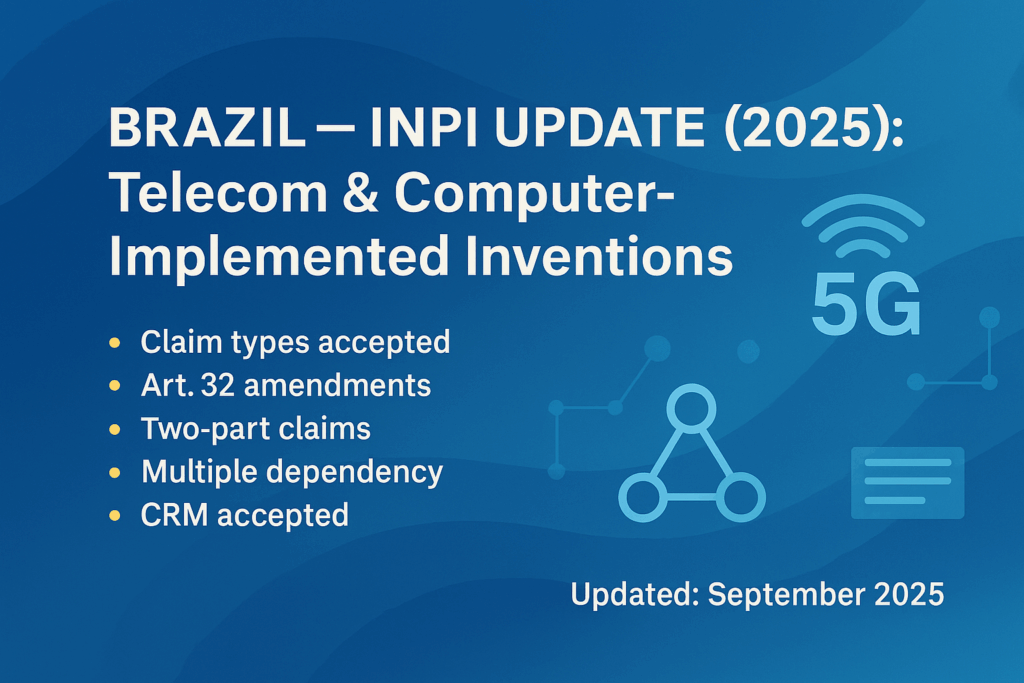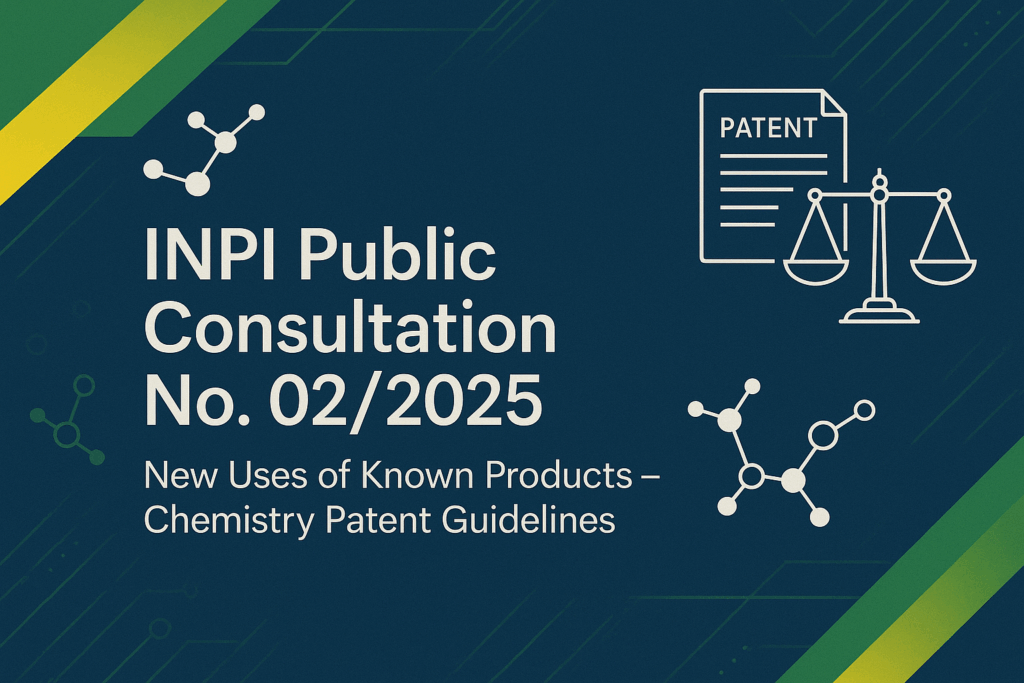News

BRAZIL IP BRIEFING: INPI DO’S AND DON’TS FOR TELECOM & COMPUTER-IMPLEMENTED CLAIMS
Full pdf version of the English translation available here.
Under Art. 32 of the Brazilian IP Law (IPL), the claim set may be amended, and additional claims may be presented before the examination request, provided that all amended/new matter is fully supported by the application as originally filed. After the examination request, INPI (Brazilian PTO) will accept only restrictive or clarifying amendments. Introducing new claim categories, broadening scope, or changing the subject matter submitted to examination is not accepted.
To preserve flexibility, if you wish to maintain protection in multiple categories (for example, apparatus, method, and computer-readable medium), we recommend either (i) keeping at least one independent claim per desired category at the time of the examination request, or (ii) considering a divisional before allowance for any additional category that you do not intend to pursue in the parent.
INPI’s examination queue is generally organized by the date of the examination request: the earlier we file the request, the sooner the case enters the examination pipeline (subject to acceleration programs, where applicable).
Our recommendations before we pay the examination fees:
Two-part claim format (preferred in Brazil): Independent claims should use preamble + characterizing clause. To minimize avoidable office actions, we typically insert the characterizing clause at filing or before REx. Please review the English version of the pending claims and indicate where the characterizing clause should begin for each independent claim.
Excess-claim fees and multiple dependents: Extra official fees apply to examination requests with more than 10 claims. If fee control is a priority, consider reducing the total count and using multiple dependent claims, which are acceptable in Brazil.
Independent claims per category and multiple dependency – accepted vs. not accepted (or discouraged) wordings:
- Independent claims per category: INPI usually objects to more than one independent in the same category, except where they define essential, technically alternative embodiments. Consolidation is advisable unless strong technical reasons justify the alternatives.
- Multiple dependency – accepted examples (safe):
“The device of claim 1 or 2.”
• “The method according to any one of claims 1 to 3.”
• “The system according to any one of claims 1, 3, or 5.”
• “The device according to any one of claims 1 to 3 and 5.”
• “The computer-readable medium of any one of claims 8 to 10.”
- Multiple dependency – not accepted or discouraged (with reasons):
“The device of any preceding claim.” (ambiguous; may mix categories.)
• “The device according to claims 1 and 2.” (conjunctive “and” suggests cumulative dependency; prefer “or/any one of”.)
• “The device of claim 1–3.” (improper punctuation; write “1 to 3”.)
• “The device according to any claim herein.” (indefinite reference.)
• “The device of claim 2 or 10” where claim 10 is a method. (cross-category dependency is improper.)
- Multiple dependent depending on another multiple dependent. (Although sometimes tolerated, it is prone to clarity and counting issues; we recommend avoiding it.)
Preserving claim categories: The examination request is effectively the last practical opportunity to include new categories in the application. If the Applicant intends to drop a category before or when paying the examination fees, it may be difficult to reintroduce it later in prosecution. If that category remains commercially relevant, either retain one independent in the parent at REx or instruct a divisional before allowance.
Reference signs in the claims: Where drawings depict the technical features, claims should include the corresponding reference numerals (in parentheses) where necessary to improve understanding. Reference signs do not limit the scope; they serve as technical support for clarity. If the signs are omitted, the Examiner may request their insertion to align with current Brazilian practice.
Focus on Telecom & Computer-Implemented Inventions
Executive summary
INPI accepts method, system/device, and computer-readable medium (CRM) claims for telecom and computer-implemented inventions provided that the claimed subject matter delivers a technical effect and does not fall under the exclusions of Art. 10 of IPL (for example, “computer programs per se” or mere presentation of information). The most strategic window to shape scope is before the examination request (REx). After REx, amendments are limited to restrictive or clarifying changes under Art. 32 of IPL.
What to avoid according to the INPI’s rules:
Claims for categories that fall directly under the restrictions in Art. 10 of the IPL are not accepted.
Examples: claims for categories such as software, computer programs, computer program products, algorithms, applications, code, among others, are not accepted.
Claims must not contain excerpts from source code so as not to cause problems of ambiguous interpretation, and consequently lack of clarity, in relation to item V of Art. 10 of the IPL.
Terms such as “means for” in product claims should not be used when they cause ambiguity and lack of clarity. In such cases, the claim should technically specify the claimed means instead of using the expression “means for”.
When there are no grounds in the specification, the use of the expression “means for” to broaden the scope of protection is not allowed. When the means are specific to the implementation of that functionality, it shall be mandatory that such specification of the means used is claimed.
Example: the expression “means for data storage” is not acceptable when the specification specifies that for the proposed invention to achieve the desired results. There is a need for the use of a “DRAM memory” and there are no grounds for the invention to properly work with any type of memory.
A claim that claims a medium containing a mathematical, financial, commercial, accounting, educational, advertising, lottery, inspection, therapeutic or diagnostic method, as well as the computer program that implements it, is not considered an invention, since the method falls within the restrictions of Art. 10 of the IPL.
In the case of an invention that is the medium per se for recording or transporting data (CD, DVD, Blu-ray, flash drive, signal, database, etc.), it must be claimed for its physical features or for the way in which the data is written or organised, and not for the content of the information recorded on it.
A medium claim defined by a computer program per se is not considered an invention because its content falls under Art. 10 of the IPL. Claims defined by expressions that can be interpreted as synonyms of terms “computer program”, such as software, firmware and application.
Example: The following claims are not accepted: “Recording medium containing a computer program characterized by executing steps A, B and C”, “Computer-readable memory containing recorded software characterized by the software implements the method with steps A and B” or “computer-readable medium characterized by a computer program”.
In a claim, expressions such as “recording medium(s)”, “storage medium(s)”, among others, are not accepted when the term “medium(s)” can be interpreted as both a method (set of steps) and a physical device, making the claim ambiguous and, therefore, unclear and imprecise.
1) Claim categories INPI accepts (and drafting that passes)
Method / Process
- Draft as a sequence of technical steps that produce a measurable technical effect (for example, reduced latency, improved throughput or spectral efficiency, lower energy consumption).
- Sample pattern:
“A method comprising: [technical step 1]; [technical step 2]; …; wherein the processing reduces [metric] relative to baseline scheduling by at least [X%] under identical conditions.”
System / Device / Apparatus
- Recite concrete components or a processor configured to perform the method operations. For telecom, name the network entities explicitly (for example, user equipment (UE), gNB/base station, core network node).
- Sample pattern:
“A gNB (20) comprising: a transceiver (22); and a processor (24) configured to execute instructions to perform the method of claim 1.” - When the system claim cannot be defined in structural terms, it can be described in terms of “means plus functions”.
- Example: system for automatic control of mechanical gear shifting comprising a fuel choke and a mechanical gear shifting transmission characterised by comprising: i) a device for detecting the actual gear ratio used during each starting operation, and ii) a memory for storing the actual gear ratio used during each starting operation.
Computer-Readable Medium (CRM)
- Define a non-transitory computer-readable (storage) medium by instructions that, when executed by at least one processor, cause performance of the method of claim X.
- Sample pattern (preferred):
“A non-transitory computer-readable storage medium comprising instructions which, when executed by at least one processor, cause the processor to perform the method of any one of claims 1 to 3.”
2) Telecom-specific pointers (H04 and related)
- Use precise entities and interfaces: UE, gNB, scheduler, CSI feedback module, beam management unit, core node.
- Tie limitations to network metrics and procedures (for example, HARQ round-trip time, PUSCH resource allocation, handover failure rate, CSI reporting periodicity).
- Provide a technical mechanism rather than purely normative references; standards (for example, 3GPP) can be background context, not the claim’s essence.
- For split architectures (CU/DU, O-RAN, edge/cloud), mirror method ↔ node claims and include a CRM counterpart.
3) Computer-implemented inventions (general IIC)
- Show a full technical pipeline: input → processing → state transformation → output with a measurable improvement.
- Keep a CRM that mirrors the main method.
4) Amendments under Art. 32 of IPL (what is possible and when)
Before the Examination Request (REx)
- Highest flexibility: you may add or adjust claims and include categories (method, system, CRM), provided everything is supported in the original disclosure (no added matter).
- Recommended moves:
- Insert a CRM aligned to the main method, if missing.
- Consolidate multiple independents per category into one robust independent plus dependent fallbacks.
- Align the title to match the independent claim categories that will go to REx.
After the Examination Request
- Only restrictive or clarifying amendments are admitted: incorporate dependent features into the independent, narrow ranges, remove alternatives, correct obvious translation/clerical errors, and formal adjustments (two-part, reference signs).
- Not accepted: broadening scope, adding new categories not present at REx, or shifting the technical focus.
- If a separate line of protection is needed, consider a divisional before allowance (manage double-patenting risk; align scopes).
5) Ready-to-use micro-templates
- Method (telecom scheduler):
“A method for uplink resource allocation in a wireless network, comprising: receiving, at a gNB (20), scheduling request metrics including buffer status and pathloss; computing a priority index based on [technical formula]; assigning PUSCH resources to a UE (10) according to the index and a latency target; and transmitting a grant, wherein the allocation reduces average HARQ round-trip time relative to baseline scheduling by at least [X%] under identical load.”
- System (gNB):
“A gNB (20) comprising: a transceiver (22); and a processor (24) configured to execute instructions to perform the method of claim 1.”
- CRM:
“A non-transitory computer-readable storage medium comprising instructions which, when executed by at least one processor, cause the processor to perform the method of any one of claims 1 to 3.”
6) Action checklist for in-house teams
- Confirm which independent categories you want at REx (method / system / CRM).
- Normalize to one independent per category unless essential alternatives are justified.
- Insert or adjust the CRM to mirror the method.
- Convert independents to two-part form; add reference numerals where drawings require.
- Prepare pre-REx amendments with a support map and an Art. 32 statement.
- Align the title to the independent claim categories.
- Consider divisional filing before allowance if an additional line of protection is commercially relevant.
- Budget for excess-claim fees if more than 10 claims will be examined.
How Simões IP can help:
If you would like a quick audit of a live case (telecom or computer-implemented invention), do not hesitate to contact us at international@simoes-ip.com.
Disclaimer: Please note that this document is provided for general informational purposes only and does not constitute legal advice. Brazilian legislation and INPI rules are subject to change. If you require advice on a specific matter, please contact us so that we may assess your case under the applicable law and the most recent INPI practice.
© Simões Intellectual Property – Brazil 2025





